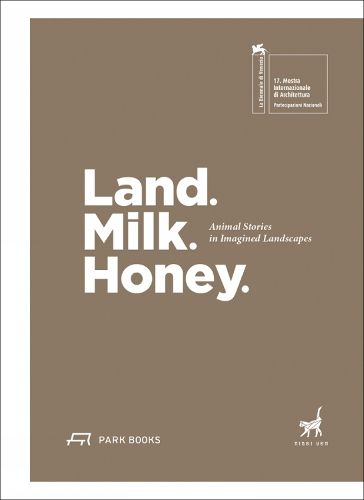Readings Newsletter
Become a Readings Member to make your shopping experience even easier.
Sign in or sign up for free!
You’re not far away from qualifying for FREE standard shipping within Australia
You’ve qualified for FREE standard shipping within Australia
The cart is loading…






The biblical metaphor of a Land of Milk and Honey has denoted for millennia a prophecy and promise for plenitude. This book, published in conjunction with the Israeli Pavilion at the 17th International Architecture Exhibition of the Venice Biennale, examines the reciprocal relations between humans, animals, and the environment within the context of modern Palestine-Israel, and demonstrates how this promise has become an action-plan over the course of the twentieth century. Through this lens, Land. Milk. Honey investigates how colonialism, settlement, urbanisation, infrastructure, and mechanised agriculture radically reshaped the environment of the contested territory of Palestine-Israel, and altered human-animal relationships. It shows how the celebrated metamorphosis of the region into a prosperous agricultural landscape was entangled with irreparable damage to the local fauna and flora, as well as the disruption of human communities and ways of living. And it highlights the predicaments that both the environment and its inhabitants are facing after the territory has over a century been the test bed of modernist aspirations for plenitude. The fundamental changes the region has gone through are portrayed through the stories of five local animals: cow, goat, honey-bee, water-buffalo, and bat. These case-studies and a zoo-centric analysis construct a spatial history of a place in five acts: Mechanization Territory, Cohabitation, Extinction and the Post-Human. A rich collection of literary excerpts, historical documents, archival photos, as well as short original vignettes brings about the story of this remarkable transfiguration and redesign. AUTHORS: Rachel Gottesman is a historian and writer, and a lecturer at Jerusalem’s Bezalel Academy of Arts and Design and at Shenkar College of Engineering and Design in Ramat Gan. Tamar Novick is a senior research scholar at the Max Planck Institute for the History of Science in Berlin, where she leads a working group on animals and knowledge. Iddo Ginat is an architect and curator, and a lecturer at Jerusalem’s Bezalel Academy of Arts and Design and at Shenkar College of Engineering and Design in Ramat Gan. Dan Hasson is an architect, exhibition designer, and lecturer at Jerusalem’s Bezalel Academy of Arts and Design. Yonatan Cohen is an architect and urbanist and heading Architecture and Design at Mosaic, an Arizona-based construction-technology enterprise. 50 colour, 130 b/w illustrations
$9.00 standard shipping within Australia
FREE standard shipping within Australia for orders over $100.00
Express & International shipping calculated at checkout
The biblical metaphor of a Land of Milk and Honey has denoted for millennia a prophecy and promise for plenitude. This book, published in conjunction with the Israeli Pavilion at the 17th International Architecture Exhibition of the Venice Biennale, examines the reciprocal relations between humans, animals, and the environment within the context of modern Palestine-Israel, and demonstrates how this promise has become an action-plan over the course of the twentieth century. Through this lens, Land. Milk. Honey investigates how colonialism, settlement, urbanisation, infrastructure, and mechanised agriculture radically reshaped the environment of the contested territory of Palestine-Israel, and altered human-animal relationships. It shows how the celebrated metamorphosis of the region into a prosperous agricultural landscape was entangled with irreparable damage to the local fauna and flora, as well as the disruption of human communities and ways of living. And it highlights the predicaments that both the environment and its inhabitants are facing after the territory has over a century been the test bed of modernist aspirations for plenitude. The fundamental changes the region has gone through are portrayed through the stories of five local animals: cow, goat, honey-bee, water-buffalo, and bat. These case-studies and a zoo-centric analysis construct a spatial history of a place in five acts: Mechanization Territory, Cohabitation, Extinction and the Post-Human. A rich collection of literary excerpts, historical documents, archival photos, as well as short original vignettes brings about the story of this remarkable transfiguration and redesign. AUTHORS: Rachel Gottesman is a historian and writer, and a lecturer at Jerusalem’s Bezalel Academy of Arts and Design and at Shenkar College of Engineering and Design in Ramat Gan. Tamar Novick is a senior research scholar at the Max Planck Institute for the History of Science in Berlin, where she leads a working group on animals and knowledge. Iddo Ginat is an architect and curator, and a lecturer at Jerusalem’s Bezalel Academy of Arts and Design and at Shenkar College of Engineering and Design in Ramat Gan. Dan Hasson is an architect, exhibition designer, and lecturer at Jerusalem’s Bezalel Academy of Arts and Design. Yonatan Cohen is an architect and urbanist and heading Architecture and Design at Mosaic, an Arizona-based construction-technology enterprise. 50 colour, 130 b/w illustrations